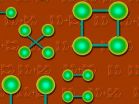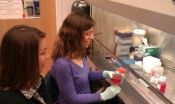(Press-News.org) Researchers from the Vienna Center for Quantum Science and Technology at the University of Vienna and the Institute of Quantum Optics and Quantum Information at the Austrian Academy of Sciences used a quantum mechanical system in the laboratory to simulate complex many-body systems. This experiment, which is published in Nature Physics, promises future quantum simulators enormous potential insights into unknown quantum phenomena.
Already the behavior of relatively small quantum systems cannot be calculated because quantum states contain much more information than their classical counter-parts. However, if another quantum system is used to simulate the quantum system of interest, then answers about the properties of the complex quantum system can be obtained.
When is a quantum system frustrated?
Currently, many international groups are focusing their research on frustrated quantum systems, which have been conjectured to explain high-temperature superconductivity. A quantum system is frustrated if competing requirements cannot be satisfied simultaneously. The Viennese research group realized for the first time an experimental quantum simulation, where the frustration regarding the "pairing" of correlations was closely investigated.
Using two pairs of entangled photons, a frustrated quantum system could be simulated that consists of four particles. "Just the recent development of our quantum technology allows us to not only rebuild other quantum systems, but also to simulate its dynamics" says Philip Walther (University of Vienna). "Now we can prepare quantum states of individual photons to gain insights into other quantum systems", explains Xiao-song Ma (Austrian Academy of Sciences).Therefore, two in polarization entangled photons exhibit in many ways the same quantum physical properties as for example electrons in matter.
Conflict over partnerships
The research team of international scientists from China, Serbia, New Zeeland and Austria prepared single photons that were facing the conflict over partnerships between each other. Each photon can establish a single bond to only one partner exclusively, but wants to get correlated with several partners – obviously this leads to frustration. As a result, the quantum system uses "tricks" that allow quantum fluctuations that different pairings can coexist as superposition.
The work of the Viennese group underlines that quantum simulations are a very good tool for calculating quantum states of matter and are thus opening the path for the investigation of more complex systems.
INFORMATION:
Publication
Xiao-song Ma, Borivoje Dakic, William Naylor, Anton Zeilinger & Philip Walther
Quantum simulation of the wavefunction to probe frustrated Heisenberg spin systems
Nature Physics 7, 399-405 (2011) doi:10.1038/nphys1919
Quantum simulation with light: Frustrations between photon pairs
2011-05-08
ELSE PRESS RELEASES FROM THIS DATE:
Normal stem cells made to look and act like cancer stem cells
2011-05-08
CHAPEL HILL, N.C. – Researchers at the University of North Carolina at Chapel Hill School of Medicine, after isolating normal stem cells that form the developing placenta, have given them the same properties of stem cells associated with an aggressive type of breast cancer.
The scientific first opens the door for developing novel targeted therapies aimed at triple negative breast cancer. Known also as TNBC, this is a highly recurrent tumor that spreads aggressively beyond its original site in the breast and carries a poor prognosis for patients who have it.
The study ...
Scientists sequence genomes of 2 major threats to American food and fuel
2011-05-08
An international team of researchers co-led by a University of Minnesota scientist has sequenced the genomes of two fungal pathogens -- one that threatens global wheat supplies and another that limits production of a tree crop valued as a future source for biofuel.
The sequencing of the genetic codes of wheat stem rust pathogen (Puccinia graminis) and poplar leaf rust pathogen (Melampsora larici-populina) is expected to help researchers develop control strategies to address worldwide threats to wheat fields and tree plantations. The study, which was published this week ...
Who knows you best? Not you, say psychologists
2011-05-08
Know thyself. That was Socrates' advice, and it squares with conventional wisdom. "It's a natural tendency to think we know ourselves better than others do," says Washington University in St. Louis assistant professor Simine Vazire.
But a new article by Vazire and her colleague Erika N. Carlson reviews the research and suggests an addendum to the philosopher's edict: Ask a friend. "There are aspects of personality that others know about us that we don't know ourselves, and vice-versa," says Vazire. "To get a complete picture of a personality, you need both perspectives." ...
Seed mixtures and insurance pest management: Future norm in the Corn Belt?
2011-05-08
As the use of biotechnology increases and more companies move forward with the U.S. Environmental Protection Agency's approval to begin full-scale commercialization of seed mixtures in transgenic insecticidal corn, many researchers believe pest monitoring will become even more difficult.
"Seed mixtures may make insect resistance management (IRM) risky because of larval behavior and greater adoption of insecticidal corn," said David Onstad, professor in the Department of Crop Sciences at the University of Illinois and lead author in a recent article published in the Journal ...
Scientists afflict computers with schizophrenia to better understand the human brain
2011-05-08
AUSTIN, Texas—Computer networks that can't forget fast enough can show symptoms of a kind of virtual schizophrenia, giving researchers further clues to the inner workings of schizophrenic brains, researchers at The University of Texas at Austin and Yale University have found.
The researchers used a virtual computer model, or "neural network," to simulate the excessive release of dopamine in the brain. They found that the network recalled memories in a distinctly schizophrenic-like fashion.
Their results were published in April in Biological Psychiatry.
"The hypothesis ...
More than 20 percent of atheist scientists are spiritual
2011-05-08
More than 20 percent of atheist scientists are spiritual, according to new research from Rice University. Though the general public marries spirituality and religion, the study found that spirituality is a separate idea – one that more closely aligns with scientific discovery – for "spiritual atheist" scientists.
The research will be published in the June issue of Sociology of Religion.
Through in-depth interviews with 275 natural and social scientists at elite universities, the Rice researchers found that 72 of the scientists said they have a spirituality that is ...
Einstein researchers find key gene in childhood cancer
2011-05-08
May 5, 2011 – (BRONX, NY) – There are no effective treatments for rhabdoid tumors – aggressive childhood cancers that usually strike children under three years old and affect the brain or kidneys. The disease is extremely rare – fewer than 10 cases are diagnosed each year in the U.S. – but is particularly difficult to treat and almost always fatal.
Now scientists at Albert Einstein College of Medicine of Yeshiva University have identified a target for potential therapies for these tumors: a gene called Aurora A that is vital for tumor growth. The research team was led ...
New online mechanism for electric vehicle charging
2011-05-08
Researchers at the University of Southampton have designed a new pricing mechanism that could change the way in which electric vehicles are charged.
It is based on an online auction protocol that makes it possible to charge electric vehicles without overloading the local electricity network.
The paper entitled Online Mechanism Design for Electric Vehicle Charging was presented this week at AAMAS 2011 – the Tenth Conference on Autonomous Agents and Multiagent Systems, and outlines a system where electric vehicle owners use computerised agents to bid for the power to ...
Geology highlights: New research posted May 4, 2011
2011-05-08
Boulder, CO, USA – New research posted online in pre-issue publication on 4 May (corresponding to the June 2011 print issue) includes the first record of shelled amoeba living in association with seafloor seeps of methane; trilobites in North China and Spain; logjams and mountain streams in the Colorado Front Range; the discovery of micrometeorites in 240 million-year-old sediments; a revelation by Integrated Ocean Drilling Program of an extensive microbial community in the deep biosphere; and further study in relation to the L'Aquila (2009), Wenchuan (2008), Sumatra-Andaman ...
The case for maintaining current regulations on I-131 therapy
2011-05-08
Reston, Va. (May 5, 2011) – Two articles in the June issue of The Journal of Nuclear Medicine make a case for maintaining current U.S. Nuclear Regulatory Commission (NRC) regulations on the release of patients who undergo radioactive iodine treatments for thyroid cancer, known as I-131. Currently, the NRC recommends outpatient treatment for patients receiving radioactive iodine after total or near-total thyroidectomy; however, several groups have been urging NRC to mandate overnight hospital stays to protect others from a perceived risk of radiation exposure.
The article, ...

